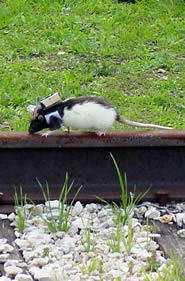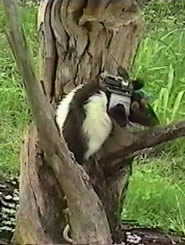Here come the
RatbotsDesire drives
remote-controlled rodents.
2
May 2002
TOM
CLARKE
 |
| A ratbot takes the
pleasure line. |
| © S. Talwar et
al. | | |
Remote-controlled rats could soon be detecting
earthquake survivors or leading bomb-disposal teams to
buried land mines.
Signals from a laptop up to 500 metres away make the
rats run, climb, jump and even cross brightly lit open
spaces, contrary to their instincts. The rodents carry a
backpack containing a radio receiver and a power source
that transmits the signals into their brains through
electrical probes the breadth of a hair.
"They work for pleasure," says Sanjiv Talwar, the
bioengineer at the State University of New York who led
the research team. One electrode stimulates the rat's
medial forebrain bundle, or MFB, the 'feelgood' centre
of the mammalian brain. "The rat feels nirvana," Talwar
says.
Two more electrodes stimulate the brain region that
normally processes signals from the rat's left and right
whiskers.
Now the team hopes to work out how to record nerve
impulses from a rat's nose when it detects an odour such
as TNT or the human body. Then 'ratbots' equipped with
satellite positioning tags could be used as smart
sensors. The research arm of the US defence department
is funding the work.
But the research has as much potential in the
emerging field of neuroprosthetics according to learning
and memory expert Samuel Deadwyler of Wake Forest
University in Winston-Salem, North Carolina. Artificial
stimulation of brain regions could bypass damaged nerves
that once controlled muscles in paralysed people. "This
approach could restore those linkages," says
Deadwyler.
Learning for pleasure
Talwar's team train the wired-up rats to turn left or
right in a maze according to the artificial whisker
stimuli. A jolt to the MFB rewards the rats for correct
behaviour. After a week's training the rats turn on cue
without reward.
Thereafter frequent pleasure pulses motivate trained
rats to navigate through virtually any environment.
Extra pulses spur them on to challenges like climbing or
jumping.
 |
| Instinct overrides desire
at a dangerous height. |
| © S. Talwar et
al. | | |
There is a limit to what the animals can be made to
do: instinct tempers their eagerness for reward. For
example, even continuous MFB stimulation cannot make a
rat jump from a dangerous height.
Manipulating animal's minds, especially for dangerous
missions, raises ethical questions. "Debate is certainly
needed," admits Talwar. But he points out that the rats
live as long as normal, and when not wearing
mind-altering backpacks they are just like any other
rats. "They're not zombies, they work with their
instincts," he says.
In a way, ratbots are an extension of classical
behavioural experiments in which animals learn to
perform tasks in return for food, say. It's just that
the reward for leaning, as far as a ratbot is concerned,
comes from within. This virtual learning could make
ratbots a new model for studying animal
behaviour. |


